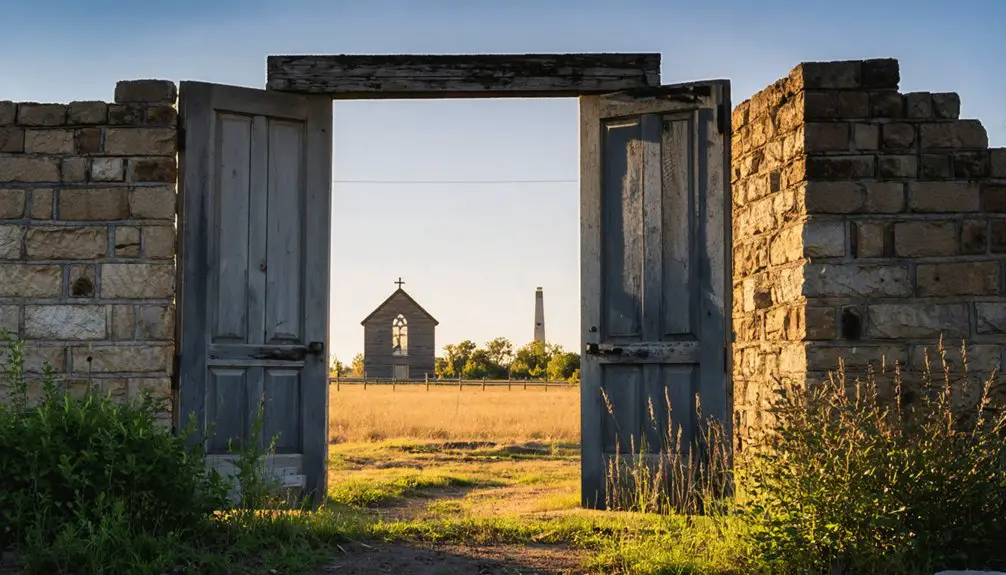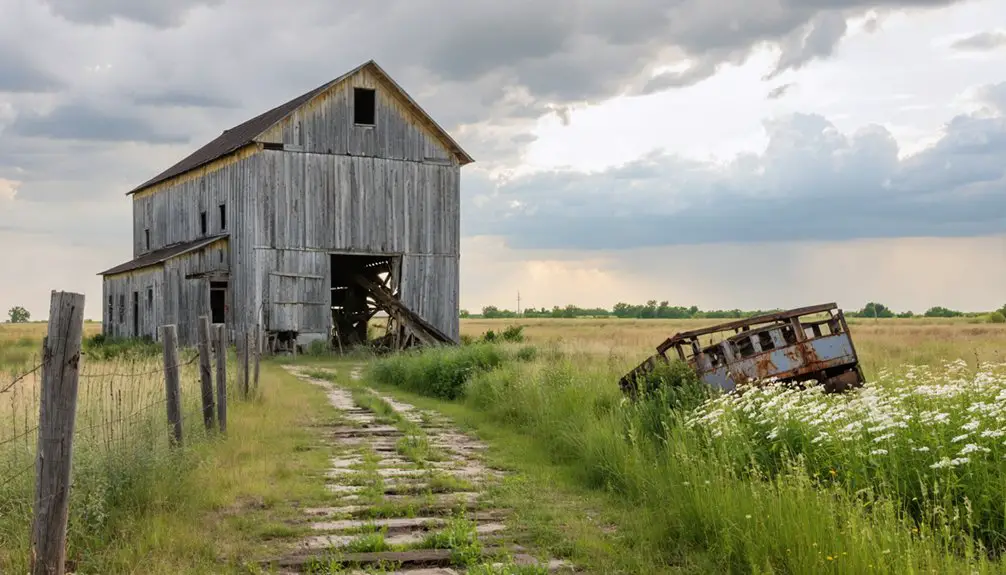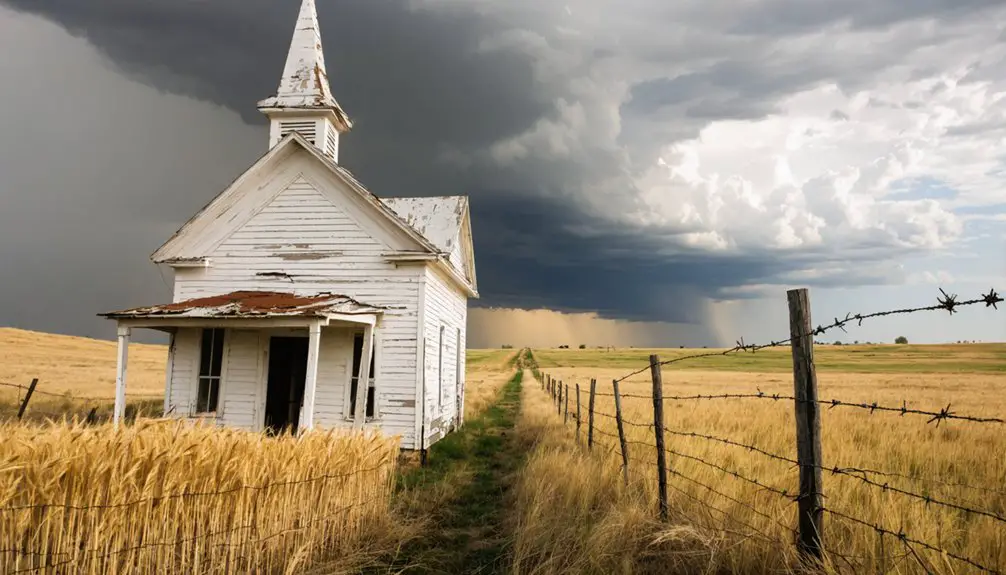You’ll find Freedom Colony’s remains 4 miles west of Fulton, Kansas, where twenty-five Black families established a cooperative settlement in 1897. They built a self-sustaining community along the Little Osage River through shared coal mining, farming, and lumber operations. The colony required unanimous approval for new members and property deposits to guarantee solidarity. This unique experiment in communal living offers fascinating insights into post-Reconstruction Black settlements in Kansas.
Key Takeaways
- Freedom Colony was established in 1897 along Kansas’s Little Osage River as a cooperative settlement focused on communal labor and industry.
- The settlement featured coal mines, farmland, and lumber operations managed through a unique system of cooperative ownership.
- Twenty-five founding families from Texas established the colony as part of the Exoduster Movement seeking land ownership and self-governance.
- The colony operated under Branch 199 of the General Labor Exchange, requiring unanimous membership approval and property deposits.
- The site’s original location, 4 miles west of Fulton in Bourbon County, is now abandoned, marking it as a ghost town.
Origins and Establishment on the Little Osage River
When the General Labor Exchange established Freedom Colony in 1897 along Kansas’s Little Osage River, they selected a 60-acre site just 4 miles west of Fulton in Bourbon County.
The location held deep cultural heritage as former Osage Nation territory, with the river’s significance stretching back generations before the tribe’s forced relocation westward through various treaties. The Little Osages maintained three villages along the region’s waterways before their eventual displacement.
You’ll find the colony’s founding was rooted in addressing widespread unemployment through communal labor and cooperative industry.
They’ve restricted membership to those unanimously accepted by existing members, requiring permanent property deposits.
With a strong emphasis on self-sufficiency, the colony developed industrial schools to provide vocational training.
The settlement offered life leases on town lots, payable in installments, while maintaining strict control over their communistic enterprise.
Though growth remained limited, the colony developed diverse operations including farming, mining, and lumber production to sustain its selective membership.
The General Labor Exchange Connection
As Branch 199 of the General Labor Exchange, Freedom Colony operated under a rigorous organizational structure that shaped every aspect of its development.
You’ll find that membership required a unanimous vote and property deposit, ensuring tight-knit labor solidarity among colonists. The exchange’s cooperative principles guided their economic activities, including farming, coal mining, and lumber operations. Founded during the severe economic depression of the late 1890s, the colony provided much-needed stability for struggling workers.
You can trace how the colony protected its workers through an equitable system of exchanging services and products, insulating them from external capitalist pressures.
The organization’s commitment to helping unemployed workers manifested in their structured property system, with life leases available for town lots.
Through the exchange network, members accessed the Howard farm’s valuable resources – coal, oil, and natural gas – while maintaining collective control over their economic destiny.
Cooperative Economic Model and Membership Rules
You’d find that membership in Freedom Colony required a significant commitment, as prospective members needed to make a permanent property deposit and receive unanimous approval from existing colonists.
African Americans often pooled their resources to establish and maintain successful cooperative communities like Freedom Colony, drawing from their long tradition of mutual aid and collective economic practices.
The colony’s labor exchange system operated through cooperative ownership of major assets, including the coal mine and community warehouse, which provided essential employment opportunities. Similar to Cooperation Jackson’s Really Really Free Market, the system emphasized mutual exchange without monetary transactions.
Your participation in the colony’s economy would have centered around cooperative ventures in farming, coal mining, and lumber production, with options to lease additional agricultural land or purchase life leases on city lots.
Property Deposit Requirements
Because the Freedom Colony operated on cooperative economic principles, its membership requirements centered on a strict property deposit system that served multiple functions.
You’d need to make a permanent property deposit in an amount deemed satisfactory by existing members, demonstrating your economic commitment to the colony’s success. This system required unanimous approval from current members before you could join.
Your property stakes would include the ability to purchase life leases on town lots, ranging from $40 for one acre to $140 for four lots, with installment payment options available. The structure promoted worker self-management through shared ownership and democratic decision-making processes.
The deposit framework helped guarantee the colony’s stability while balancing private ownership with community control of utilities and major industries. This careful vetting process maintained the cooperative’s democratic principles and protected its shared economic interests.
Labor Exchange Structure
While operating as a branch of the General Labor Exchange organization, Freedom Colony implemented a sophisticated cooperative economic model that balanced individual ownership with communal ventures.
You’d find a labor organization that required unanimous member approval for new admissions, ensuring tight community resilience through careful growth control.
The economic structure combined private ownership of personal items and leased properties with cooperative management of major industries like coal mining, lumber production, and farming.
You couldn’t join unless you were at least 15 years old and willing to make a permanent property deposit valued by existing members.
The colony’s warehouse served as the central hub for exchanging goods and services, while municipally-owned utilities demonstrated the community’s commitment to collective resource management.
Daily Life and Economic Activities
As settlers established themselves in Freedom Colony, agricultural pursuits formed the backbone of their daily economic activities. You’d find families working their homesteads, growing crops suited to Kansas prairie soil while raising livestock to sustain their households. The self-sufficient community thrived through cooperative farming and shared resources.
The settler lifestyle centered on working the land, with everyone contributing to farm labor and home-based production. You’d see a bustling community where general stores stocked thousands of dollars worth of merchandise, and hay baling operations processed up to 20,000 tons annually. From 1900 to 1930, the area gained recognition as The Hay Capital of the World.
Local businesses, including meat markets and furniture stores, served the growing population’s needs. The Colony Free Press, established in 1882, kept you informed about market conditions and community news.
Despite challenges like fires and weather-related setbacks, the community’s agricultural practices and diverse economic activities helped maintain its independence and resilience.
Role in Post-Reconstruction Black Settlement Movement

During the tumultuous post-Reconstruction era, Freedom Colony emerged as a essential component of the black settlement movement, joining other African American communities like Nicodemus in creating autonomous spaces across Kansas.
Freedom Colony stood as a beacon of black autonomy in post-Reconstruction Kansas, joining communities like Nicodemus in building independent African American spaces.
The Freedmen’s Relief Association provided vital aid and resources to the settlers establishing themselves in these new communities.
You’ll find that this settlement exemplified community resilience through its connection to the General Labor Exchange organization and its deliberate structure promoting racial autonomy.
The colony was initially established by twenty-five founding families who journeyed from Texas seeking independence and opportunity.
As part of the broader Exoduster Movement, Freedom Colony represented African Americans’ determined pursuit of true freedom through land ownership and self-governance.
You can trace how the colony’s establishment in 1897 aligned with a national pattern of black communal settlements that countered Southern discrimination.
Through cooperative economic structures and shared industries, Freedom Colony offered its residents an alternative to sharecropping and Jim Crow oppression.
Property Acquisition and Land Management
Through its strategic property management system, Freedom Colony established a rigidly controlled 60-acre settlement along Kansas’s Little Osage River in 1897.
You’d have found a unique land leasing structure where members could secure life leases on city lots – $40 for one acre or $140 for four lots, with flexible payment options available.
The colony’s property system centered on communal resources, including a coal shaft, farmland, and lumber operations.
You couldn’t simply buy your way in; membership required both a unanimous vote and a satisfactory property deposit. This careful approach guaranteed the community’s stability and self-sufficiency.
The colony’s strategic location near Fulton, Kansas, provided essential access to markets while maintaining the settlement’s independence through its innovative land management practices.
Coal Mining and Agricultural Ventures

While many Kansas settlements relied solely on farming, Freedom Colony distinguished itself by operating a dual economy centered on coal mining and agriculture.
You’ll find evidence of their innovative approach in the coal shaft they operated on their 60-acre property, where they employed mining techniques common to late 19th century Kansas, including room-and-pillar extraction methods.
The colony’s coal production contributed to the region’s industrial growth, particularly supporting railroad expansion, while their cooperative ownership model set them apart from corporate mining towns.
Freedom Colony’s cooperative coal mining enterprise fueled local industrial development while offering an alternative to traditional corporate mining operations.
They balanced their mining operations with strategic farming activities, cultivating crops and sharing agricultural labor among community members.
This diversified approach provided both food security and economic stability, with revenues from coal sales supporting their communal business ventures and self-sufficient lifestyle.
Comparison With Other Kansas Black Towns
As Kansas attracted numerous African American settlers seeking autonomy after Reconstruction, Freedom Colony emerged alongside other notable black settlements like Nicodemus and the Hodgeman County Colony.
You’ll find these communities shared similar community aspirations, with settlers from Kentucky and other southern states establishing self-governed towns with their own schools, churches, and local institutions.
While Nicodemus gained the most historical recognition as a National Historic Site, Freedom Colony and Hodgeman County Colony faced comparable economic challenges.
All three settlements struggled with harsh environmental conditions and limited market access due to segregation. Their settlers relied heavily on farming and coal mining, though these ventures often proved insufficient for long-term sustainability.
Despite their differences in fame, these towns represented unified visions of black self-determination and independence from systemic discrimination.
Legacy and Historical Significance

Founded in 1897, Freedom Colony stood as a remarkable experiment in communal living and economic cooperation under the General Labor Exchange organization.
You’ll find its legacy deeply rooted in Kansas’s diverse social history, where it demonstrated extraordinary community resilience through its unique approach to economic management and social cohesion.
Located along the Little Osage River, the colony’s innovative structure required unanimous decision-making and emphasized sustainable industries like farming, coal mining, and lumber production.
Along the Little Osage River, Freedom Colony pioneered democratic governance while building sustainable industries in America’s heartland.
While it’s not widely recognized today as a major historical site, you can appreciate its significance as a reflection of the era’s broader social movements and labor reforms.
The colony’s commitment to preserving wealth within the community and facilitating equitable exchange of services offers valuable insights into late 19th-century communal experiments.
Frequently Asked Questions
What Happened to the Original Buildings and Structures of Freedom Colony?
While some original structures survive as private homes, most buildings deteriorated due to fires, weather, and abandonment. You’ll find only foundations remain, though historical preservation efforts maintain select landmarks like churches.
How Many Families Lived in Freedom Colony During Its Peak?
You won’t find exact family demographics for Freedom Colony’s peak population, as historical records don’t document specific numbers, though archives indicate membership was “slowly growing” during its operational period.
Were There Any Schools or Churches Established Within Freedom Colony?
You’ll find no confirmed records of formal schools or churches, though education initiatives and community gatherings likely occurred informally within shared spaces, reflecting the colony’s communal, cooperative living structure.
What Caused the Eventual Decline and Abandonment of Freedom Colony?
You’ll find that severe economic challenges, including limited farming success and job opportunities, led to population decline as settlers sought better prospects elsewhere, eventually causing Freedom Colony’s abandonment.
Did Freedom Colony Maintain Connections With Other African American Settlements Nearby?
You’ll find Freedom Colony maintained strong community ties with nearby African American settlements through historical networks of shared resources, cultural exchange, economic cooperation, and communication channels between churches and social organizations.
References
- https://www.frrandp.com/2024/01/blog-post_01.html
- https://www.ksgenweb.org/archives/1912/f/freedom_colony.html
- https://legendsofkansas.com/colony-kansas/
- https://www.legendsofamerica.com/ks-nicodemus/
- https://legendsofkansas.com/dunlap-kansas/
- https://accessgenealogy.com/kansas/great-and-little-osage.htm
- https://www.kancoll.org/books/cutler/deschist/indhistp3.html
- https://findingourwayhome.blog/2019/04/15/osage-river-bend/
- https://abandonedkansas.wordpress.com/2020/12/12/osage-indians-in-kansas/
- https://www.kancoll.org/khq/1977/77_1_grant.htm



